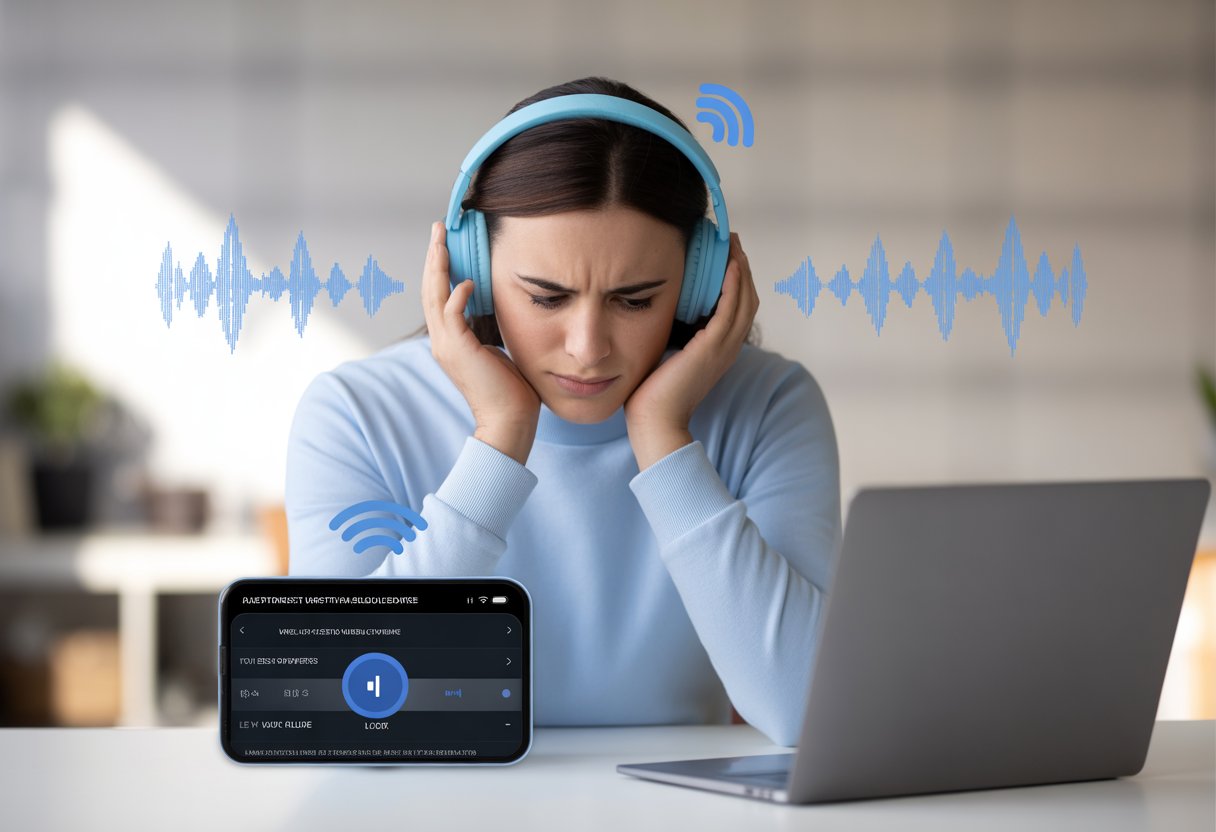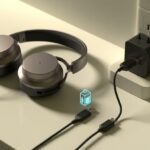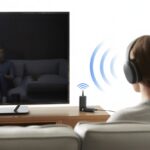We’ve all been there—ready to jam out, but our Bluetooth headphones barely whisper, even at max volume. Bluetooth headphones can have low volume because of device settings, software issues, or connection glitches. Sometimes it feels like our headphones just checked out for a nap.

Even when we crank every slider up, the sound stays stubbornly low. Maybe it’s a Bluetooth setting, a rogue audio enhancement, or some sneaky volume limit buried in our phone or computer.
Before we start blaming our ears or tossing the headphones, let’s figure out why this keeps happening—and how to get our music back to “dance party” levels instead of “library” mode.
Common Reasons for Low Volume on Bluetooth Headphones
You know the feeling: your favorite song is playing, but it barely registers. Low audio on Bluetooth headphones can feel like a cruel joke when all we want is that full, rich sound. So what’s really holding our volume back?
Bluetooth Device Settings
Sometimes, our device settings act like strict bouncers, keeping our music outside the party. Phones and laptops often hide an “absolute volume” control. If we don’t set it up right, the headphones can’t hit their full potential.
We should check our Bluetooth settings. Tapping the device in the Bluetooth menu and poking around for audio or volume options can make a big difference.
Some Android phones have this bug where device and headphone volumes fight each other. Tweaking or disabling independent controls usually helps, making things louder and clearer.
If we get lost, guides or forums can help. People often suggest going into Bluetooth settings, clicking the gear next to the headphones, and looking for volume or audio options. Even a small change here can save us from silent suffering, as folks mention in this Reddit thread.
Headphone Hardware Limitations
No matter how many settings we poke, sometimes our Bluetooth headphones just don’t have the muscle. Cheaper headphones—or ones that have taken a few tumbles—can have hardware limits. Speaker size, battery age, and even earwax buildup can all play a part.
Speaker drivers might just not be able to push out more sound. Sometimes, headphones get damaged over time from drops, water, or maybe a mischievous cat. We should check for obvious problems, like dirt in the ear cups or cracked pads.
If the headphones have always been quiet, maybe the company designed them that way to protect our ears. But if they suddenly go quiet, it could mean the hardware is wearing out. Either way, it’s tough to get more from headphones that are already maxed out, as mentioned in this hardware issues guide.
Restricted Volume Settings on Connected Devices
Even if we max out the physical volume, our phone, tablet, or computer might secretly limit the output. Thanks to safety laws, some devices come with “maximum volume” settings. It’s meant to protect our hearing, but it sure doesn’t help when we want to crank up our favorite track.
We might need to dig through settings for things like “Volume Limiter” or “Hearing Protection.” Some Android versions have a built-in cap to prevent hearing loss. On Windows, exclusive audio modes or enhancements can mess with the max output. Disabling unnecessary enhancements or raising the built-in volume limit can sometimes break us out of maximum volume jail, as shown in this Windows guide.
Double check for parental controls or third-party audio software that might set extra limits. With a bit of digging, we can usually make our Bluetooth headphones louder and actually enjoy our music.
Troubleshooting Steps for Boosting Sound
Low volume on Bluetooth headphones can feel like someone swapped your concert for elevator music. Luckily, we can turn things up by tweaking settings, restarting devices, and reconnecting our headphones. Let’s break down the steps for getting better sound.
Checking App Settings
Before we throw our headphones across the room, we should check the app settings. Some apps have their own volume controls that don’t sync with the device volume. Streaming platforms and music players often hide independent sliders. We should look there first.
A sneaky “volume limiter” can lower output volume. This setting is usually for ear protection. If the sound is too low even at max, we need to hunt for “volume limit” options in the phone or app settings and turn them off.
Some apps also offer audio enhancements or equalizers that can mess with volume. Try toggling them on and off to see if it helps. If nothing works, reinstalling the app might clear up weird volume bugs.
Restarting Devices
It’s wild how often “turn it off and on again” works. If our headphones suddenly sound muffled, restarting both the Bluetooth headphones and the connected device can fix it.
Here’s a quick rundown:
- Turn off the Bluetooth headphones.
- Power off the phone, tablet, or computer.
- Count to ten (or just take a breath).
- Turn the device back on, then the headphones.
This reset clears out minor glitches and gets the devices talking again. We should also check for software updates on both devices, since old firmware can cause problems.
Bluetooth Reconnection Tips
Bad Bluetooth connections can leave us scratching our heads. Sometimes, unpairing and re-pairing the devices does the trick. No need to get mad—just try a fresh start.
Go to Bluetooth settings, find the headphones, and hit “Forget” or “Remove.” Restart Bluetooth, then reconnect. Make sure nothing blocks the signal, like walls or, I dunno, angry pigeons.
If that doesn’t help, try pairing the headphones with a different device. If the sound is still low, the headphones might be the issue. More tips can be found in these Bluetooth reconnection tips.
Impact of Media Types on Volume Output
Different types of media play at different volumes. Our headphones never really know what’s coming—sometimes it’s a music banger, other times it’s a super quiet podcast.
Differences in Streaming Music Services
Switching between streaming services can feel like a weird audio experiment. Some, like Spotify or Apple Music, use volume normalization to keep songs at a similar loudness. Others don’t, so suddenly your playlist is whispering and your ears are confused.
Track quality matters too. High-definition tracks usually sound louder and fuller, while low-bitrate files seem quiet or flat. Even within one service, some songs hit hard and others fade out, thanks to different mastering practices.
If you like quick fixes, look for “volume leveling” or “loudness normalization” in your music app. If not, well, we’ll just keep fiddling with the volume buttons.
Volume Discrepancies with Podcasts and MP3s
Podcasts and MP3s are even trickier. Podcasts are recorded everywhere—from fancy studios to folks under blankets in their bedrooms. That means volume levels swing wildly, from “can you even hear this?” to “why did that intro blast my ears?”
MP3 files are all over the place too. Some are ripped loud, others are soft, depending on the source. If we mix playlists with songs, podcasts, and random old MP3s, don’t be shocked if our headphones seem lost.
We can sometimes fix this with audio normalization tools or by adjusting the media player’s settings—if only it were that easy to normalize everything else. For more info, check out this explanation of quiet headphones and fixes.
Audio Quality and Its Relationship to Volume
Sometimes turning up the volume just makes bad audio louder—not better. The way we hear sound depends not only on how loud our headphones get, but how well they deliver the music, especially bass and clarity.
Quality Sound Versus Loud Sound
We’ve all cranked up our Bluetooth headphones hoping the music would finally sound clear and punchy. But if the audio quality stinks, high volume only turns up the noise. Loud sound isn’t always good sound. Sometimes, our ears just want a break.
Bluetooth headphones use special audio codecs to transfer music wirelessly. Lower-quality codecs or switching to mono mode (like when the mic is on) compress the sound. This compression kills detail and dynamic range. We might think the headphones are just quiet, but really, the sound is flat and lifeless. If you’ve ever noticed Bluetooth headphones sounding worse with the mic on, this is probably why.
Louder isn’t always better—sometimes it’s just, well, louder.
How Bass Performance Affects Your Experience
We love a good bass drop. Who doesn’t want their ears to rumble a bit? But weak bass makes music and games sound thin—even if the volume is high. Without strong bass, everything feels less exciting.
Bass gives songs and movies that punchy, powerful feel. If headphones have tiny speakers or bad tuning, the low sounds just disappear. Our ears are less sensitive to bass at lower volumes, so we keep turning it up, hoping to “find” the bass, but all we get is more treble—not more thump. Suddenly our favorite beats sound like they’re coming from a distant speaker at a middle school dance.
Lack of bass isn’t just a preference—it actually changes how we hear and enjoy every sound. Even at max volume, weak bass can leave us feeling underwhelmed.
Keeping Your Bluetooth Headphones Up to Date
We all want our wireless headphones to sound great. Nobody wants to deal with frustratingly low volume just because we missed a simple fix.
Honestly, just keeping up with updates and basic maintenance can save us from those annoying volume issues. Nobody likes having their favorite songs ruined by weak sound.
Importance of Product Updates
Ever get the feeling your headphones worked better yesterday? Yeah, me too. Most wireless headphones need regular firmware updates. Even our headphones want to keep up with the times.
A new update can squash bugs that make the volume weird. Updates can also boost sound quality and help our headphones play nice with whatever phone we’re using this week.
Some brands offer their own apps for updates, which makes life easier. We just connect, tap “update,” and let it do its thing.
Those little notifications? Try not to ignore them—they’re not just there to bug us. They actually help us dodge problems like low volume or strange connection issues.
Manufacturers slip in tiny improvements all the time. We might not notice every change, but our ears probably do.
If it’s been a while since the last update, maybe check the brand’s website or app. A quick tap might save us from pretending to enjoy music we can barely hear.
Servicing Your Product for Better Performance
Even with updates, your headphones sometimes just need a little TLC.
Honestly, it’s like sending them to the spa—just without the cucumber slices.
Dust, earwax, and sweaty fingerprints can block the speakers or microphones.
That’s how you end up with that weird “muffled” sound, even though you didn’t ask for it.
Here’s a quick checklist for headphone health:
- Gently wipe ear pads and speakers with a soft cloth.
- Use a toothpick or brush to pick out small bits of debris.
- Charge your headphones fully before you start troubleshooting volume problems.
- Look for physical damage, like frayed wires or any cracks.
If cleaning doesn’t solve the problem, you’ll probably need some professional help—or at least a call to customer support.
Plenty of brands offer repairs, and if you’re lucky, your warranty might save the day. Regular cleaning and a little attention really help keep your headphones sounding their best.
- Why is My Fitness Tracker Not Pairing with Google Fit? Trouble in App Paradise - October 27, 2025
- Why do my Bluetooth headphones have low volume? Turning Them Up Without Blowing Your Mind - October 27, 2025
- Best Bluetooth Headphones for Watching TV: Binge Without Waking the Neighbors - October 26, 2025






